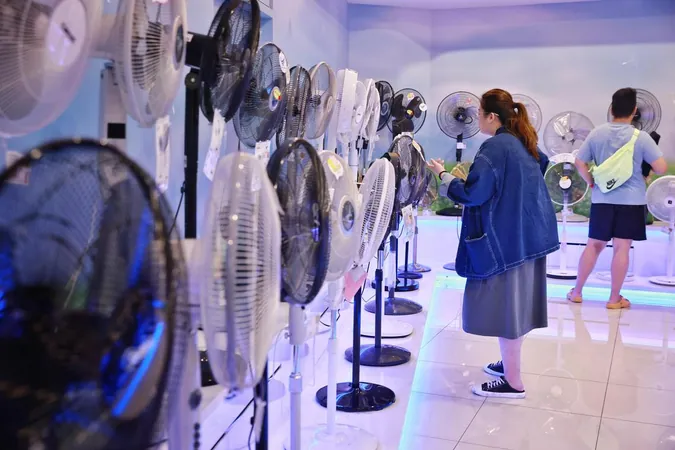
Beat the Heat: Expert Tips on Energy-Saving Cooling Solutions Amid Rising Temperatures
2025-01-09
Author: Arjun
Introduction
As the sweltering heat continues to challenge residents in Southeast Asia, experts at the recently held First Global Heat Health Information Network (GHHIN) South-east Asia Heat Health Forum in Singapore are advocating innovative and energy-saving methods to stay cool. One standout recommendation? Utilize fans in conjunction with air conditioning set at a higher temperature!
Hybrid Cooling Strategy
In a pilot study at the Zero Energy Plus Building in Singapore, researchers discovered that setting the air conditioner to a comfortable 26.5°C while using ceiling fans provided similar comfort levels as a cooler 24°C environment, all while cutting energy consumption by an astonishing 30%. This 'hybrid cooling' strategy highlights the potential for both comfort and efficiency in combating rising temperatures.
Climate Change Impact
The findings, presented by Professor Stefano Schiavon from the University of California, Berkeley, underscore the pressing need for effective heat management solutions as temperatures continue to rise globally. Climate change is making its mark, causing severe heatwaves throughout Southeast Asia, impacting agricultural yields in countries like Laos, Indonesia, Malaysia, and the Philippines.
Vulnerable Populations
The current climate crisis has made outdoor workers, especially those in the agriculture sector (which employs approximately 96 million individuals in the region), vulnerable to heat-related illnesses and reduced productivity. The forum explored climate adaptation strategies, including national heat action plans and community-level initiatives aimed at protecting at-risk populations.
Research on Sleep Quality
The challenges faced due to high humidity levels in Southeast Asia, which inhibit sweat evaporation and exacerbate heat stress, led to a fresh investigation targeting the sleep quality of construction workers and residents in air-conditioned environments. This important research aims to identify effective strategies for improving thermal comfort at night as warmer evenings become increasingly common.
Urban Heat Island Effect
Professor Winston Chow from Singapore Management University highlighted the urban heat island effect, where urban areas remain significantly hotter than rural environments due to extensive development. Chow indicated that rapid urbanization contributes over 50% of increased temperatures in cities like Singapore, making a compelling case for comprehensive heat action and climate resilience plans.
Need for Sustainable Financing
Moreover, the need for sustainable financing in climate adaptation is paramount, as highlighted by various experts at the forum. With a majority of climate finance still centered on mitigation efforts, there is an urgent call for increased investment in adaptation measures.
Scalable and Affordable Interventions
Professor Ollie Jay underscored the importance of scalable and affordable interventions. Simple solutions such as fans, shade structures, and misting systems can significantly mitigate heat stress for vulnerable populations who lack access to advanced cooling technology.
Conclusion
However, experts caution that solutions must consider local climate conditions. While fans can be beneficial in humid regions, they may increase discomfort in hot and dry areas. As we continue to grapple with the effects of climate change and rising temperatures, it is crucial to adopt practical and sustainable cooling measures to protect our communities. The discourse at the GHHIN forum sets the stage for an urgent call to action, not just for governments and policymakers but for the collective responsibility of us all to create safer, cooler environments.
Stay tuned for more updates and tips on how to navigate and thrive in an increasingly heated world!

 Brasil (PT)
Brasil (PT)
 Canada (EN)
Canada (EN)
 Chile (ES)
Chile (ES)
 Česko (CS)
Česko (CS)
 대한민국 (KO)
대한민국 (KO)
 España (ES)
España (ES)
 France (FR)
France (FR)
 Hong Kong (EN)
Hong Kong (EN)
 Italia (IT)
Italia (IT)
 日本 (JA)
日本 (JA)
 Magyarország (HU)
Magyarország (HU)
 Norge (NO)
Norge (NO)
 Polska (PL)
Polska (PL)
 Schweiz (DE)
Schweiz (DE)
 Singapore (EN)
Singapore (EN)
 Sverige (SV)
Sverige (SV)
 Suomi (FI)
Suomi (FI)
 Türkiye (TR)
Türkiye (TR)
 الإمارات العربية المتحدة (AR)
الإمارات العربية المتحدة (AR)